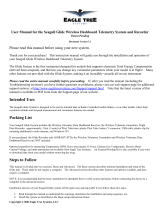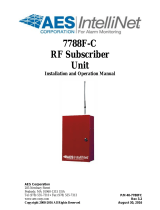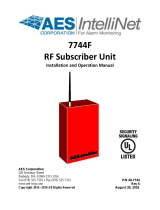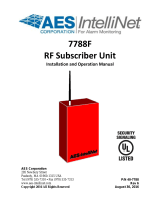Page is loading ...

PRODUCT INFORMATION
BULLETIN
105 Bonnie Drive
Butler, PA 16002
724-283-4681
724-283-5939 (fax)
www.bwieagle.com
AIR-EAGLE® SR PLUS
2.4 GHz RF Transmitter
MODEL 36U-HH-9
DESCRIPTION
The AIR-EAGLE SR PLUS TX Is a handheld R.F. transmitter capable of
sending up to sixteen unique digital commands to an Air-Eagle SR
Receiver located up to 600 feet away. Any number of transmitters and
receivers can be combined to create a medium-range radio frequency
system that operates hazardous or hard-to-reach equipment from safe,
convenient locations. Eight user-programmable frequencies allow
multiple systems to operate simultaneously in the same area without
interference. This transmitter will automatically go into “sleep” mode
when no buttons are being depressed on the unit to dramatically
extend battery life.
APPROVALS
United States (FCC)
MCQ-XBEE3
Canada (IC)
1846A-XBEE3
Europe (CE)
ETSI
INITIAL SET-UP
This transmitter comes factory set to frequency 1 and power level 4 (max
range of 600 feet). If you wish to change the default settings, follow the
instructions for FREQUENCY PROGRAMMING AND POWER LEVEL
PROGRAMMING on page 2.
GENERAL OPERATION
This transmitter sends up to 16 independent commands. Each button
sends an RF Code for that channel. Button 1 transmits channel 1
commands, button 2 transmits channel 2 commands etc. To send
commands 9 thru 16, the P/Shift button must be used. As noted under
CONTROLS & INDICATORS, the P/Shift button serves two purposes. As
the “P” button, it allows you to program the transmitter to operate on a
different frequency. As the “Shift” button, it allows you to send commands
9 thru 16 to the receiver.
To use as the “P” button, you must press and hold the button for
approximately 5 seconds to enter programming mode. (See
PROGRAMMING section for more details).
To use as the “Shift” button, press the P/Shift button momentarily. The TX
LED will begin to flash rapidly indicating you’re in the Shift mode. While in
shift mode pressing buttons 1 thru 8 transmit the higher numbered code
for that button. The transmitter will stay in the Shift mode as long as
buttons are being depressed within 10 seconds of one another. During
this time, the TX LED gives visual confirmation that you’re in Shift mode
by continuously flashing GREEN/RED rapidly. After 10 seconds has
elapsed with no buttons depressed, the transmitter will revert back to
standard mode and the TX LED will extinguish. If, while in Shift mode, you
wish to transmit a button 1 thru 8 command and don’t want to wait for the
Shift mode to time out, you can simply press the P/Shift button
momentarily to revert back to the standard mode.
Dimensions – 6.71” H x 3.27” W x 1.32” D
CONTROLS & INDICATORS
TX LED
LED illuminates “RED” continuously while button is
depressed and unit is transmitting. When this LED
blinks during a transmission, the battery needs to
be recharged.
Keypad
Pushbuttons
1 thru 8
Transmit CH.1 thru 8 individual button RF codes to
the receiver
Pushbutton
P/Shift
The P/Shift button performs three functions:
1. If button is depressed momentarily and another
button is then pressed within 10 seconds, the
higher code for that button is transmitted. This
allows for transmission of pushbutton codes 9 thru
16.
2. If button is depressed for longer than 5 seconds,
the transmitter will enter “programming” mode.
See PROGRAMMING section.
3. See “Battery Charge Status” for using P/shift to
see battery level.
Keypad
Pushbuttons
9 thru 16
Transmit CH. 9 thru 16 individual button RF codes
to the receiver

AIR-EAGLE® SR PLUS
2.4 GHz RF Transmitter
MODEL 36U-HH-9
BATTERY CHARGE STATUS
Hold the P/Shift button then tap button 1 and release both buttons to
see the current charge level. Note that you should give about 1 second
delay before pressing button 1.
High
TX LED blinks GREEN 4 times
Med-High
TX LED blinks GREEN 3 times
Med-Low
TX LED blinks GREEN 2 times
Low
TX LED blinks RED 1 time
Needs charged
TX LED blinks RED while transmitting and
after any button released
FREQUENCY PROGRAMMING
Please read through these instructions completely before beginning
programming procedure!
At any time, you can check the current frequency setting by depressing
the P/Shift button, for approximately 5 seconds, until the TX LED is
illuminated RED. Then release the P/Shift button and watch as the TX
LED stays RED for about 10 seconds, goes out, then begins to blink. The
TX LED will blink RED one, two, three or four times for Frequencies 1 thru
4, or will blink GREEN one, two, three or four times for Frequencies 5 thru
8 accordingly. See table below for clarification.
LED Flashes:
Indicates Unit is Operating On:
RED – one time
Frequency 1
RED – two times
Frequency 2
RED – three times
Frequency 3
RED – four times
Frequency 4
GREEN – one time
Frequency 5
GREEN – two times
Frequency 6
GREEN – three times
Frequency 7
GREEN – four times
Frequency 8
To change the setting, follow these steps:
To select from Frequencies 1 thru 8:
1. Depress the P/Shift button until the TX LED is illuminated RED.
(Approximately 5 seconds)
2. Release the P/Shift button, then while the TX LED is still
illuminated RED, depress button #1 to select “Frequency 1” or
button #2 to select “Frequency 2” etc. If the transmit LED goes
out before you have selected a network, no settings will have
changed, and the LED will blink corresponding to the frequency
that the TX is currently set to. You must then begin again at
step 1 if you wish to change the current setting.
3. The TX LED will blink to confirm that your frequency selection
has been accepted, and then will go out. For instance, if you
have selected Frequency #1, the TX LED will blink RED once
to confirm. If you have selected Frequency #6, the TX LED
blinks GREEN two times to confirm.
Programming is now complete and the transmitter is active for normal
operation.
You may repeat the above procedure if you wish to change the frequency
at any time. See note* in SPECIFICATIONS.
POWER LEVEL PROGRAMMING
At any time, you can check the current power level by depressing the
P/Shift Button, for approximately 8 seconds, until the TX LED starts
BLINKING GREEN. Then release the buttons and watch as the TX
continues to blink for 10 seconds, goes out, then begins to blink again.
The TX LED will blink GREEN one, two, three or four times corresponding
the power level setting (see table below)
LED Flashes:
Indicates Unit is Set To:
GREEN – one time
Power Level 1 – Approx 100 Ft Range
GREEN – two times
Power Level 2 – Approx 250 Ft Range
GREEN – three times
Power Level 3 – Approx 400 Ft Range
GREEN – four times
Power Level 4 – Approx 600 Ft Range
To change the setting, follow these steps:
To select a power level:
1. Depress the P/Shift Button until the TX LED is BLINKING
GREEN (Approximately 8 seconds)
2. Release the P/Shift Button, then while the TX LED is still
blinking GREEN, depress button #1 to select “Power Level 1”
or button #2 to select “Power Level 2” etc. If the transmit LED
goes out before you have selected a power level, no settings
will have changed, and the LED will blink corresponding to the
power level the TX is currently set to. You must then begin
again at step 1 if you wish to change the current setting.
3. The TX LED will blink to confirm that your power level selection
has been accepted, and then will go out. For instance, if you
have selected Power Level #1, the TX LED will blink GREEN
once to confirm. If you have selected Power Level #3, the TX
LED blinks GREEN three times to confirm.
SPECIFICATIONS
Keypad
Durable Sealed Membrane Keypad –
Eliminates Dust, Dirt and Moisture
Failures
Enclosure
ASA/Polycarb Blend – IP54 – Not
Water Proof!
Power Requirements
Charging cable (included) Micro USB
connector to USB A type – 5 volts 1
amp
Battery Type
Internal Sealed Lithium Rechargeable.
Capacity 3.7V 2000mAh
Battery Life (Active Usage)
Up to 2 Weeks
Battery Life (Sleep Mode)
Approximately 45 Days
Battery Recharge Time
Approximately 3 to 4 Hours
Transmit Frequency
2.4GHz Spread Spectrum
Transmitter Frequencies
8 Independent Network Frequencies
RF Output Power
User Selectable from 1mW - 60 mW
Max Transmit Range
User-Selectable from 100 - 600 Feet
Note: Range figures are estimates, based on free-air terrain with
limited sources of interference. Actual range will vary based on
transmitting power, orientation of transmitter and receiver, height
of transmitting antenna, height of receiving antenna, weather
conditions, interference sources in the area, and terrain between
receiver and transmitter, including, but not limited to, indoor and
outdoor structures such as walls, metal objects, trees, buildings,
hills, and mountains
Operating Temperature
-40o F to +185o F

AIR-EAGLE® SR PLUS
2.4 GHz RF Transmitter
MODEL 36U-HH-9
LIMITED WARRANTY STATEMENT
BWI Eagle Inc. warrants the Air-Eagle Remote Control System, if properly
used and installed, will be free from defects in material and workmanship
for a period of 1 year after date of purchase. Said warranty to include the
repair or replacement of defective equipment. This warranty does not
cover damage due to external causes, including accident, problems with
electrical power, usage not in accordance with product instructions,
misuse, neglect, alteration, repair, improper installation, or improper
testing. This warranty also does not cover water damage to any handheld
transmitter. This limited warranty, and any implied warranties that may
exist under state law, apply only to the original purchaser of the
equipment, and last only for as long as such purchaser continues to own
the equipment. This warranty replaces all other warranties, express or
implied including, but not limited to, the implied warranties or
merchantability and fitness for a particular purpose. BWI Eagle makes no
express warranties beyond those stated here. BWI disclaims without
limitation, implied warranties of merchantability and fitness for a particular
purpose. Some jurisdictions do not allow the exclusion of implied
warranties so this limitation may not apply to you. To obtain warranty
service, contact BWI Eagle for a return material authorization. When
returning equipment to BWI Eagle, the customer assumes the risk of
damage or loss during shipping and is responsible for the shipping costs
incurred.
DOCUMENT DATE: 8/5/2020 / PRODUCT REV. 0
105 Bonnie Drive
Butler, PA 16002
(724) 283-4681
Fax (724) 283-5939
www.bwieagle.com
/



